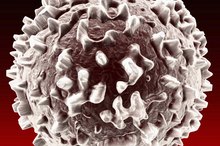Drugs That Destroy White Blood Cells or Damage Bone Marrow
White blood cells are produced by the bone marrow and have an important role in preventing infection. White blood cells and the bone marrow are very sensitive to toxins, as well as a number of prescription medications that can also kill white cells. Individuals undergoing treatments with certain drugs may have their white cell levels regularly monitored to ensure that white cell numbers do not reach dangerously low levels that could allow for an infection to develop.
If you are experiencing serious medical symptoms, seek emergency treatment immediately.
Chemotherapy Drugs
Bone marrow cells like cancer cells, undergo rapid cell division cycles and are very susceptible to the toxic effects of chemotherapeutic drugs. As common chemotherapeutic drugs are toxic to bone marrow cells, these drugs can lead to an overall decrease in white cell levels. The Mayo Clinic explains how chemotherapy kills bone marrow cells and also explains that these cells can recover with time after the end of chemotherapy. Tirgan Oncology Associates lists a number of common chemotherapeutic drugs that can lower white cell counts, including 5-FU, actionmycin D, daunorubicin, 6-MP, nitrogen mustard, and taxol 2.
- Bone marrow cells like cancer cells, undergo rapid cell division cycles and are very susceptible to the toxic effects of chemotherapeutic drugs.
- As common chemotherapeutic drugs are toxic to bone marrow cells, these drugs can lead to an overall decrease in white cell levels.
Clozapine
Medications That Boost White Blood Cells
Learn More
Clozapine is an antipsychotic drug used to treat schizophrenia in patients that do not respond to typical antipsychotic drugs. The National Alliance on Mental Illness explains that while clozapine is effective at treating schizophrenia and other mental disorders, clozapine may cause agranulocytosis, a condition in which the bone marrow fails to make white cells 3. The risk of agraulocytosis with clozapine is significant enough to limit clozapine to only severely ill schizophrenic patients with limited treatment options. Patients receiving clozapine must have a baseline white cell level and have regular monitoring of white cell numbers to ensure that clozapine use does not lead to a potentially fatal infection.
- Clozapine is an antipsychotic drug used to treat schizophrenia in patients that do not respond to typical antipsychotic drugs.
- The risk of agraulocytosis with clozapine is significant enough to limit clozapine to only severely ill schizophrenic patients with limited treatment options.
Immunosuppressive Drugs
A number of immunosuppressive drugs specifically kill white blood cells to prevent their action. While immunosuppressive drugs may be harmful to healthy individuals, such drugs are used to reduce immune responses in patients with autoimmune diseases. Immunosuppressive drugs are also used in patients undergoing organ transplants to prevent organ rejection. Clinical trial information for one immunosuppressive drug, sirolimus, explains that such drugs kill white blood cells to decrease immune response.
- A number of immunosuppressive drugs specifically kill white blood cells to prevent their action.
- While immunosuppressive drugs may be harmful to healthy individuals, such drugs are used to reduce immune responses in patients with autoimmune diseases.
Interferons
Drugs That Cause Peripheral Neuropathy
Learn More
The University of South Carolina Medical School explains that interferons are proteins of the immune system that have an important role in defending the body from viruses 5. Certain interferons, such as interferon alpha-2a, can be administered to cancer patients to help kill off tumor cells. Unfortunately, interferons can also kill white blood cells and lower white cell levels.
Related Articles
References
- Mayo Clinic: Low blood cell counts: Side effect of cancer treatment
- Tirgan Oncology Associates: List of Anti Cancer and Chemotherapy Drugs
- Clinicaltrials.gov: Sirolimus for Autoimmune Disease of Blood Cells
- University of South Carolina School of Medicine: Interferon
- Auerbach M, Adamson JW. How we diagnose and treat iron deficiency anemia. Am J Hematol. 2016;91(1):31-38. doi:10.1002/ajh.24201
- Penn State Hersey. Milton S. Hersey Medical Center. CBC Blood Test. Updated October 24, 2018.
- Whitehead L. Managing Chemotherapy-Induced Anemia with Erythropoiesis-Stimulating Agents Plus Iron. Am J Nurs. 2017;117(5):67. doi:10.1097/01.NAJ.0000516277.58981.36
- Mohandas H, Jaganathan SK, Mani MP, Ayyar M, Rohini Thevi GV. Cancer-related fatigue treatment: An overview. J Cancer Res Ther. 2017;13(6):916-929. doi:10.4103/jcrt.JCRT_50_17
- Long B, Koyfman A. Oncologic Emergencies: The Fever With Too Few Neutrophils. J Emerg Med. 2019;57(5):689-700. doi:10.1016/j.jemermed.2019.08.009
- Bond TC, Szabo E, Gabriel S, et al. Meta-analysis and indirect treatment comparison of lipegfilgrastim with pegfilgrastim and filgrastim for the reduction of chemotherapy-induced neutropenia-related events. J Oncol Pharm Pract. 2018;24(6):412-423. doi:10.1177/1078155217714859
- National Heart, Lung, and Blood Institute. Thrombocytopenia. 2019.
- Kuter DJ. Managing thrombocytopenia associated with cancer chemotherapy. Oncology (Williston Park). 2015;29(4):282-294.
- Sunkesula VC, Knighton S, Zabarsky TF, Kundrapu S, Higgins PA, Donskey CJ. Four Moments for Patient Hand Hygiene: A Patient-Centered, Provider-Facilitated Model to Improve Patient Hand Hygiene. Infect Control Hosp Epidemiol. 2015;36(8):986-989. doi:10.1017/ice.2015.78
Writer Bio
Chad Stone is a medical scientist based in the Pacific Northwest. Since 2003, Dr. Stone has has published high-profile articles on the molecular mechanisms of cardiovascular disease and cancer in journals such as Blood and the Journal of the American Heart Association. Dr. Stone is a specialist in blood biology as well as cancers of breast, colon, kidney and other tissues.








